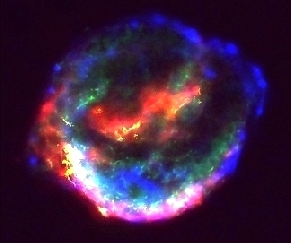
 Kepler's Supernova Remnant. This 14-light year wide shell of gas and dust is the remnant of the supernova which was observed in 1604 by the astronomer Johannes Kepler (1571-1630). This fine and detailed structure is a composite of four images taken by NASA three large space telescopes. The rightmost, yellow and red, part of the supernova marks where the sphere of gas is ramming into the surrounding interstellar medium. It was taken in the visible wavelengths by the Hubble Space Telescope. The shock wave is immediately followed by a region of hot gas and highly energized electrons shining in blue. This part of the picture was taken by the Chandra X-ray Telescope with another largely masked, red, part, taken by the Spitzer Space Telescope working in the infrared. The innermost layer of the explosion (green, partially occulted) is the thick, cooler, interior shell of the iron-rich material which was expelled from the exploded star. This picture was taken by Chandra too, in lower-energy X-rays. The supernova remnant is expanding at 2,000 km/s (4 million miles per hour) as it had peaked at the magnitude -3 when numerous European and Asiatic observers could watch the event naked-eye. picture courtesy NASA/ESA/JHU/R.Sankrit & W.Blair
Kepler's Supernova Remnant. This 14-light year wide shell of gas and dust is the remnant of the supernova which was observed in 1604 by the astronomer Johannes Kepler (1571-1630). This fine and detailed structure is a composite of four images taken by NASA three large space telescopes. The rightmost, yellow and red, part of the supernova marks where the sphere of gas is ramming into the surrounding interstellar medium. It was taken in the visible wavelengths by the Hubble Space Telescope. The shock wave is immediately followed by a region of hot gas and highly energized electrons shining in blue. This part of the picture was taken by the Chandra X-ray Telescope with another largely masked, red, part, taken by the Spitzer Space Telescope working in the infrared. The innermost layer of the explosion (green, partially occulted) is the thick, cooler, interior shell of the iron-rich material which was expelled from the exploded star. This picture was taken by Chandra too, in lower-energy X-rays. The supernova remnant is expanding at 2,000 km/s (4 million miles per hour) as it had peaked at the magnitude -3 when numerous European and Asiatic observers could watch the event naked-eye. picture courtesy NASA/ESA/JHU/R.Sankrit & W.Blair
Website Manager: G. Guichard, site 'Amateur Astronomy,' http://stars5.6te.net. Page Editor: G. Guichard. last edited: 12/28/2010. contact us at ggwebsites@outlook.com

